Kalanchoe plants are a genus in the Crassulaceae family. There are around 125 different species within this genus, most of which are shrubs or herbaceous perennials. They are tropical succulent flowering plants that are mostly native to Madagascar and large regions of tropical Africa.
A number of different plants within the Kalanchoe genus are commonly cultivated as houseplants, or used in succulent or rock gardens in warmer climes. They are popular for their drought-tolerance and ability to survive in low-water conditions.
Kalanchoe has dark green, thick waxy leaves with scalloped-edges and small, four-petaled flowers in clusters held above the foliage. It is also available in a double flowering variety with as many as 26 petals per bloom. Kalanchoe brightens the indoors with flowers in various shades of red, magenta, pink, orange, yellow and white.
- Kalanchoe thyrsiflora (Paddle Plant)
- Kalanchoe beauverdii (Beauverd’s widow’s-thrill)
- Kalanchoe beharensis (Velvet-leaf)
- Kalanchoe blossfeldiana (Flaming Kathy)
- Kalanchoe luciae (Paddle Plant)
- Kalanchoe marnieriana (Marnier’s Kalanchoe)
- Kalanchoe tomentosa (Panda Plant)
- Kalanchoe bracteata (Silver Teaspoons)
- Kalanchoe carnea (Big leaf Kalanchoe)
- Kalanchoe daigremontiana (Mother of thousands)
- Kalanchoe delagoensis (Chandelier Plant)
- Kalanchoe eriophylla (Snow White Panda Plant)
- Kalanchoe Fantastic (Kalanchoe luciae ‘Fantastic’)
- Kalanchoe fedtschenkoi (Lavender Scallops)
- Kalanchoe humilis (Spotted Kalanchoe)
- Kalanchoe prolifera (blooming boxes)
- Kalanchoe rhombopilosa (Pies from heaven)
- Kalanchoe laciniata Cathedral bells)
- Kalanchoe laxiflora (Milky Widow’s Thrill)
- Kalanchoe longiflora (tugela cliff-kalanchoe)
- Kalanchoe marmorata (Penwiper plant)
- Kalanchoe millotii (Millot Kalanchoe)
- Kalanchoe mortagei (Bryophyllum mortagei)
- Kalanchoe orgyalis (Copper Spoons)
- Kalanchoe paniculata (Large Orange Kalanchoe)
- Kalanchoe pumila (the flower dust plant)
- Kalanchoe rotundifolia (Common Kalanchoe)
- Kalanchoe scapigera (Mealy Kalanchoe)
- Kalanchoe sexangularis (Six-angled Kalanchoe)
- Kalanchoe synsepala (Cup Kalanchoe)
- Kalanchoe Tessa (Pendent flowered Kalanchoe)
- Kalanchoe tetraphylla (Flapjack Kalanchoe)
Kalanchoe thyrsiflora
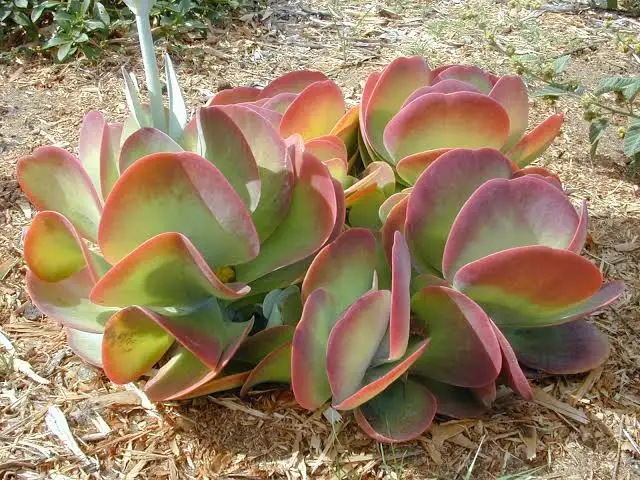
Kalanchoe thyrsiflora forms a basal rosette of large, rounded, fleshy, stalkless leaves, which are grayish-green with red margins, covered with a white powdery bloom. The inflorescence is terminal and erect with densely clustered thyrse-like panicles of greenish waxy flowers with yellow recurved lobes, narrowly urn-shaped. The plant flowers from autumn to spring, and is common in grassveld amongst rocks.
Kalanchoe beauverdii
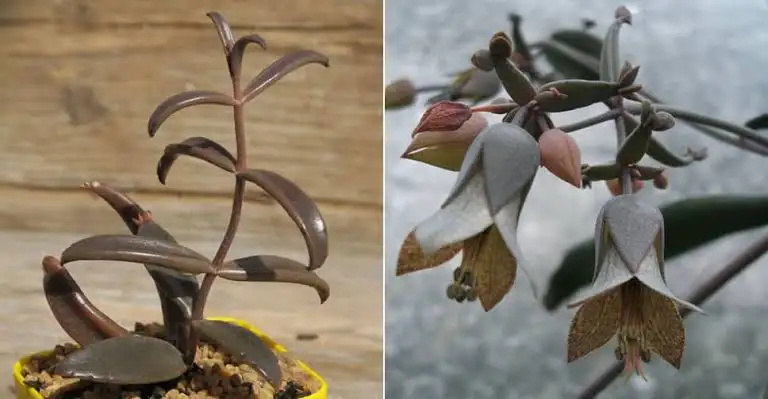
Kalanchoe beauverdii goes by the common name Beauverd’s widow’s-thrill. The species was described and named by Raymondl Hamet in the year 1907. The perennials can grow up to 3 to 5 metres. A climber with branching gray wiry stems that clamber and twine and hold narrow 1 to 2 inch long lance-shaped dark purple-black succulent leaves that are held in widely spaced opposite pairs alternating 90 degrees from the last pair. The dark purple-tinged gray-green flowers hang downwards in terminal clusters in winter and spring.
Kalanchoe beharensis

Kalanchoe beharensis, commonly called velvet-leaf, felt bush or elephant’s ear kalanchoe is a slow growing succulent tree-like shrub can grow to an eventual height of 12 ft. It has thick stems that are covered sharp angled leaf scars that likely evolved to protect the stems that hold large, undulated and folded, olive-green, slightly-triangular leaves covered in sort brown stellate (branched) hairs that gives the leaves a soft, velvety texture. Once mature, it produces small, greenish yellow flowers in winter.
Also Read: Different Types of Calathea Plants For Your Home
Kalanchoe blossfeldiana
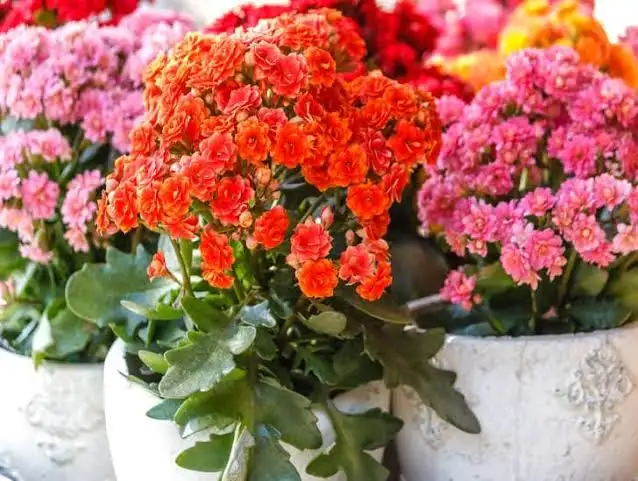
Kalanchoe blossfeldiana also referred to as Flaming Kathy, is the most popularly cultivated Kalanchoe, known for its large flowerheads and large variety of colors. It is a bushy evergreen succulent with thick, shiny, dark green leaves with scalloped edges. The dainty blooms come in soft pastel colors and in brilliant shades of red, orange, pink or yellow. This Kalanchoe flowers every 6 months or so and keeps its blooms 6 weeks or more. Although Flaming Kathy is typically used as a houseplant, it can be grown outdoors if protected from the frost.
Kalanchoe luciae
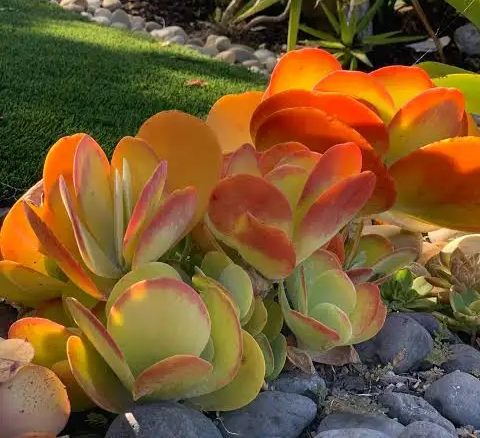
Kalanchoe luciae (Paddle Plant) is an impressive evergreen Kalanchoe with a basal rosette of thick, fleshy, rounded leaves. Resembling clam shells, the jade green leaves are adorned with vibrant red-wine tips during the cooler winter months if grown in bright light. Attractive when not blooming, this Kalanchoe is particularly striking in late winter to early spring when a 2-3 feet stem arises from its center, bearing clusters of pale yellow tubular flowers. This plant is often confused with Kalanchoe thyrsiflora which sports shorter broad leaves, doesn’t turn as red in winter and whose flowers are darker yellow and sweetly fragrant.
Kalanchoe marnieriana
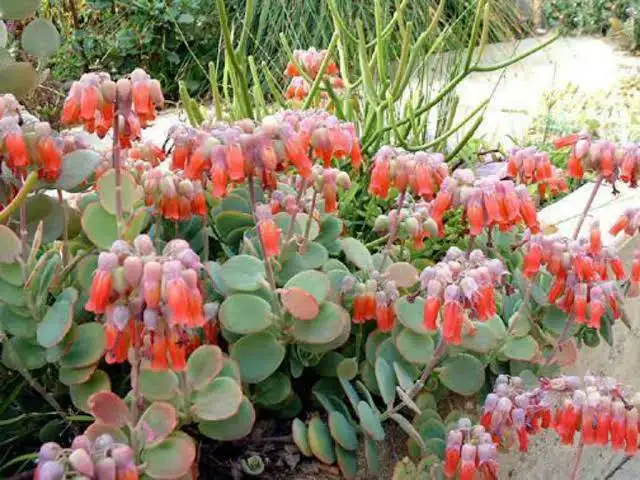
Kalanchoe marnieriana (Marnier’s Kalanchoe) is an evergreen Kalanchoe subshrub with flat, rounded, blue-green leaves. Paddle-shaped, the leaves are arranged oppositely and resemble clam shells. They are adorned with vibrant red-wine tips during the cooler winter months if grown in bright light. Attractive when not blooming, this Kalanchoe is particularly striking throughout the year, when flowering stalks arise from its center, bearing clusters of rose-pink to red, nodding flowers. Like other Kalanchoes, this plant can sporadically sprout new plantlets along the edges of leaves, which will eventually fall off, and grow into a new plant.
Kalanchoe tomentosa
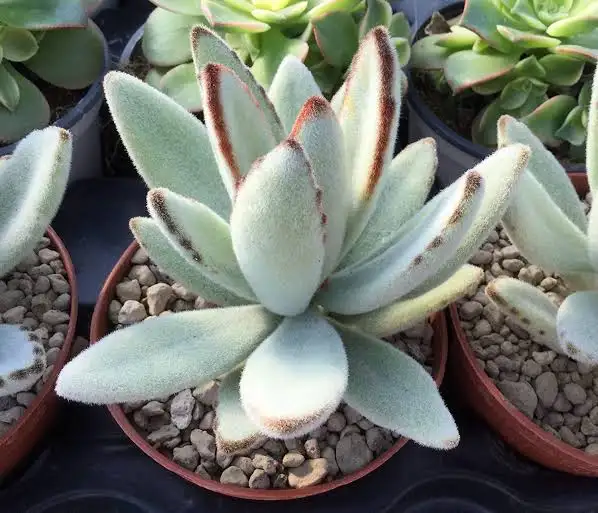
Kalanchoe tomentosa (Panda Plant) is an erect evergreen Kalanchoe with soft fuzzy, fleshy leaves, reminiscent of the ears of plush rabbits with brown stitching along the edges and tips. This plant does not bloom as often as other succulents and is grown primarily for its unusual foliage. In summer, clusters of yellow green flowers with dark brown petal tips may appear atop 18 inch stalks. Very popular as a container specimen or houseplant, this Kalanchoe is also a great choice for the garden as an accent plant or small groundcover.
Kalanchoe bracteata

Kalanchoe bracteata (Silver Teaspoons) is a small compact shrubby Kalanchoe that grows to between 4-6 feet tall. It has 1 to 2 inch long ovate leaves with a slight point at the tip and short petioles. The species can be a bit variable but the plants appear grayish silvery-white because of a pubescence of appressed short stellate hairs and a waxy substance that covers the leaves and the young 4 angled stems. The flowers on this plant are red on branched terminal inflorescences. It can become leggy with age, but can be pruned to create a more dense growth pattern.
Also Read: Different Types of Cactus For Indoor And Outdoor Spaces
Kalanchoe Carnea
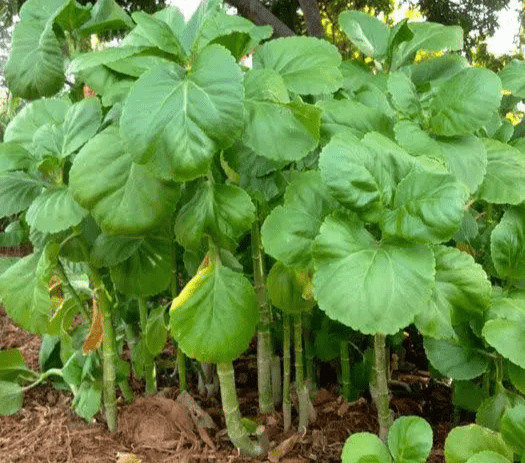
Kalanchoe Carnea, commonly known as Modoc or Big Leaf Kalanchoe is an upright growing Kalanchoe, growing between 3-4 feet tall with green glabrous leaves, 2-3 inches wide by 4-5 inches long that have blunt scalloped margins reflexed under. Showy pink flowers in terminal racemes rise above the foliage in summer. This plant is often found in shady neglected corners of older gardens where it survives without too much water. The plants look better and will flower regularly in full sun with little watering.
Kalanchoe daigremontiana
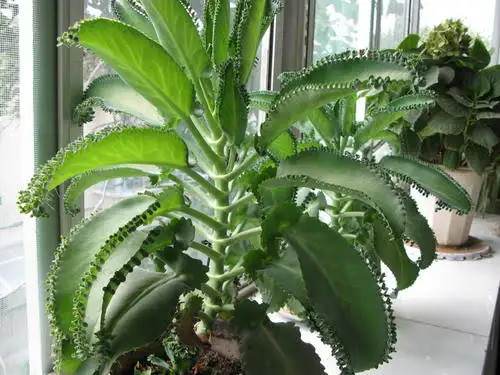
Kalanchoe daigremontiana, formerly known as Bryophyllum daigremontianum and commonly called mother of thousands, alligator plant, Devil’s backbone, crown of thorns, or Mexican hat plant, has juicy and fleshy oblong-lanceolate leaves. It has an upright trunk, and, with time, it starts to become woody from the bottom. During the winter, if kept warm, the plant blooms with beautiful tubular flowers, from gray-pink to pink-purple. It’s common name ‘Mother of Thousands’ refers to the fact that tiny plantlets, or replicates of the mother plant, are produced along the margins of each one of its leaves. “Many plants reproduce by throwing out long shoots or runners that can grow into new plants.
Kalanchoe delagoensis

Kalanchoe delagoensis (Chandelier Plant) is an erect, smooth, fleshy plants which grows to 1 m or more in height with grey-brown, fleshy, tubular-like leaves with up to seven projections at the tip of each leaf. This species blooms in winter from the tall flower spikes with clusters of bell-shaped flowers. The flowers are orange-red and occur in a cluster at the top of a single stem.
At the tips of its leaves, Kalanchoe delagoensis forms small plantlets that are able to be dislodged from the mother plant and immediately take root to form a genetically identical plant. Kalanchoe delagoensis is also extremely resistant to drought yet can survive in moist climates as well, and can grow just about anywhere. It is often found along stream banks and exposed rocks near water courses, as it can be spread by water.
Kalanchoe eriophylla
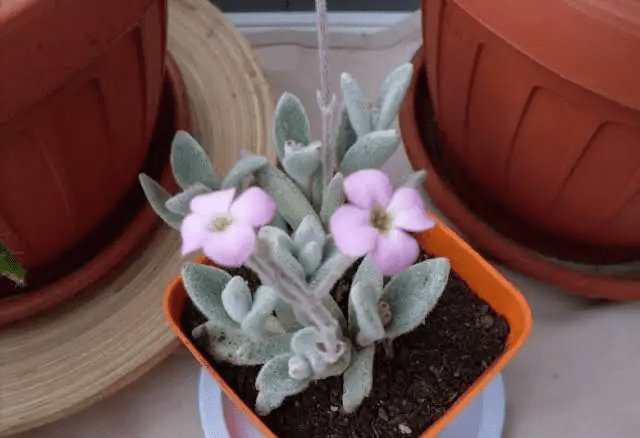
With long, narrow, and fuzzy leaves clustered along equally furry stems, Kalanchoe eriophylla ‘Snow White Panda Plant’ lives up to its name on all counts. The white coloration, which is created by the sheen of the white hairs atop otherwise bright green leaves, is visually appealing both on its own and as a contrasting element within container plantings. Reaching less than 12 inches in height, this variety will begin to form a dense mat of white foliage as it matures – and can even flush to pink when exposed to both cooler temperatures and bright sunlight.
Also Read: Different Types of Anthurium Houseplants
Kalanchoe Fantastic
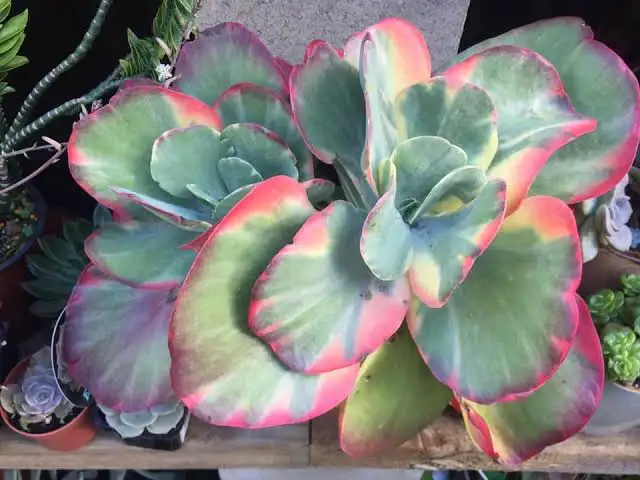
Kalanchoe Fantastic (Kalanchoe luciae ‘Fantastic’) is an amazing succulent with vividly colored foliage. The leaves are bright green variegated with yellow and the edges are reddish or pinkish depending on the individual plant. The leaves are fleshy, almost round in shape and concave. The leaves grow in rosettes like most succulents. Tubular pale yellow flowers grow on peduncles in the winter and spring.
Kalanchoe fedtschenkoi

Kalanchoe fedtschenkoi (Lavender Scallops) is a low-growing, frost-tender perennial Kalanchoe which prefers dry, open ground. It grows to 10–12 inches tall as an untidy, low, rounded herb. The stems are round, smooth and lax with visible leaf scars, often bending and touching the ground where they produce roots and new plants. Leaves are fleshy, alternate, blue-green and oval or obovate with fine scalloped edges, the edges may turn pink or red under strong sunlight or drought conditions. The tubular flowers are in corymbs, often multi-layered in good conditions. Each flower has a short calyx edged with delta-shaped segments, which is shorter than its tubular corolla. The corolla is an orange/coral/apricot color.
Kalanchoe humilis
Kalanchoe humilis (Spotted Kalanchoe) is an attractive succulent shrub with pale green leaves, usually strongly marked with purple or maroon spots. It grows up to 3 feet (90 cm) tall. Stems are simple or with few branches, woody at the base, purple or slightly glaucous, and up to 8 inches (20 cm) long. Leaves are oval and show a very beautiful brindled pattern in green and purple. Younger leaves tend to be more purplish. They are not so big, about 2-6 centimeters in width and 3-13 centimeters in length. Flowers are not so beautiful and are often removed by gardeners. They are small, erect or horizontal, dull purple to green.
Kalanchoe prolifera
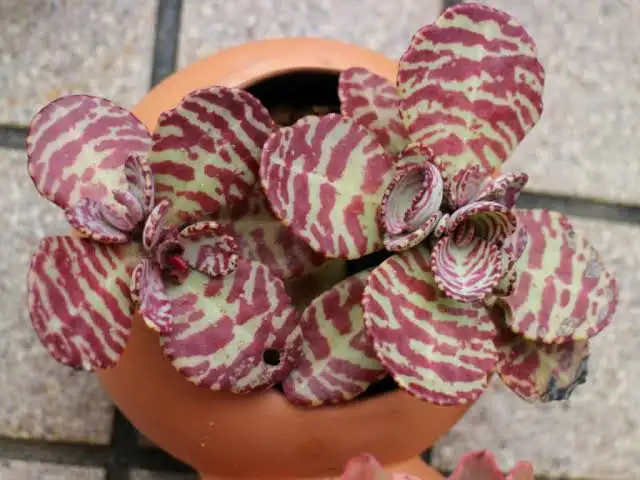
Kalanchoe prolifera (blooming boxes) is a perennial succulent that can reach up to 5 cm in diameter and 3 m tall, but when the plant reaches this height it tends to fall and to become procumbent. The stem is erect, quadrangular, unbranched, woody at the base and waxy at the apex. The leaves are large, fleshy, stout, rubbery with purple and toothed margins. The leaves are petiolate and pinnatisect, arranged like a fishbone, pale green in color and can turn on red shades in direct sunlight. Blooming occurs from late winter to early spring, after the plant gets 90 cm tall. The buds are borne at the apex of the plant and the inflorescence is a cyme, candelabra-like. The flowers are bell-shaped, with a green calyx and a red corolla.
Kalanchoe rhombopilosa

Kalanchoe rhombopilosa (Pies from heaven) is the smallest species among the Kalanchoes.The plant is a perennial shrub few branched and can reach up to 30 cm tall. The stem is thin, erect nd very hairy. The leaves are fleshy, petiolate, rhombic, with acute teeth at the top, covered with a silver-green powder and mark with coppery-brown spots. Blooming occurs in spring and the inflorescence is paniculate. The flowers are small, greenish yellow to pink with purple lines.
Also Read: Different Types of Peperomia Plants
Kalanchoe laciniata
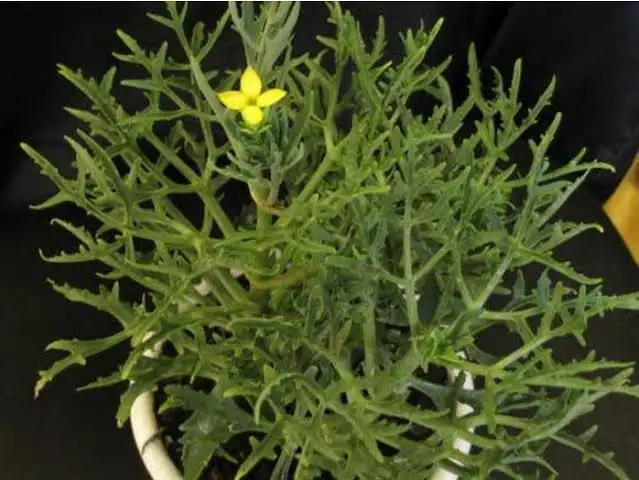
Kalanchoe laciniata, commonly known as the christmas tree plant or cathedral bells is a short-lived perennial, or possibly sometimes biennial which reach 12 inches in height with erect, simple, smooth, reddish, leafless stems. The fleshy stem is usually unbranched, it dies back to a large, underground tuber in dry conditions. The succulent leaves are petiolate, usually compound or dissected, glabrous, pale to dark green on drying. Christmas tree plant blooms in early summer to late summer from the up to 40 cm long, flat-topped, finely and densely glandular-pubescent inflorescences with flowers in dense cymes. The flowers are greenish-white to light orange in colour and grow up to 15 cm long.
Kalanchoe laxiflora

Kalanchoe laxiflora commonly known as Milky Widow’s Thrill is a subshrub which reaching up to 50 cm in height with upright shoots branch out from the base. The leaves are elliptically-shaped, gray or green, often tinged red, particularly along the margins with older leaves often a red-violet color. Milky Widow’s Thrill blooms in the spring from the dense, lanceolate cymes, up to 50 cm long inflorescence with hanging flowers on very slender, 8-16 mm long flower stalks. The flowers are orange-reddish, bell-shaped. The calyx is yellow-green or orange-red to violet. The corolla is red, red-purple, pink, pink-orange, orange-red, orange-yellow to pale yellow.
Kalanchoe longiflora

Kalanchoe longiflora, also known as tugela cliff-kalanchoe or long-flower kalanchoe is a perennial plant that can reach up to 15 cm in diameter and 40 cm tall, but when the plant reaches this height it tends to fall and to become procumbent. The stem is erect, quadrangular, branched, woody at the base and waxy at the apex. The leaves are large, fleshy, stout, sessile with purple and slightly toothed margins. The leaves are ovate to obovate, pale green in color and can turn on red shades in direct sunlight. Blooming occurs from late winter to early spring and the buds are borne at the apex of the plant. The inflorescence is a cyme, candelabra-like. The flowers are funnel-shaped, with a green calyx and a yellow corolla.
Also Read: Popular Types of Haworthia Succulents
Kalanchoe marmorata

Kalanchoe marmorata also referred to as Penwiper plant, is a shrub-like succulent that can grow 12 to 15 inches tall (30 to 38 cm.) and 15 to 20 inches wide (38 to 51 cm.). The leaves are large and gently scalloped on the edges. The foliage bears purple splotches on the creamy greenish-yellow leaves. In spring, this plant adds even more interest as it produces tall clusters of tiny white starry flowers. The flowers make excellent long-lasting cut flowers or can be part of an everlasting bouquet.
Kalanchoe millotii

Kalanchoe millotii, also called as Millot Kalanchoe, is a species of the genus Kalanchoe. This species was described by Raymond Hamet & Joseph Marie Henry Alfred Perrier de la Bâthie in 1912. It is a small succulent perennial sub-shrub which reaching to 30cm tall, with tall stems and attractive velvety, silver-lime green foliage with scalloped edges. The leaves are oval-shaped, a soft green and have a dense felt covering giving them a fuzzy look. Millot Kalanchoe bloom in summer with small clusters of long-lasting erect flowers that sit in clusters on long stalks above the plant. They are small, white and pestiferous. When the open up, the shape is like a tiny daisy.
Kalanchoe mortagei

Kalanchoe mortagei, also called as Bryophyllum mortagei is a fast growing succulent perennial or biennial plant which reaching up to 3 meters tall with erect or decumbent simple stems. The leaves are glaucous, green to bluish-green. It is very similar to Kalanchoe suarezensis but differs by having auriculate to peltate leaves, while the leaf base of Kalanchoe suarezensis is attenuate to truncate. This species blooms in mid winter to early spring from the lax corymbose panicles with small 1″-2″ in size flowers. The flowers are bell-shaped red or red-green to yellow with red-purple lines, with a bluish bloom.
Kalanchoe orgyalis
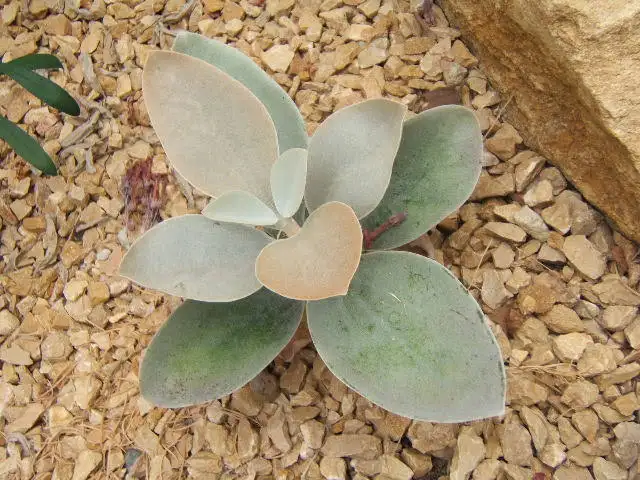
Kalanchoe orgyalis (Copper Spoons) is a much-branched slow growing shrub that can reach to 3-6 feet tall or taller with support but is more often seen as a smaller plant. It has spathulate ovate leaves that fold upward from the middle and are a bronze to gray color on the underside while the top side is felted with fine cinnamon colored hairs that eventually age to the same color as the lower surface. In the late winter to early spring appear the bright yellow flowers in terminal clusters at the branch tips.
Kalanchoe paniculata
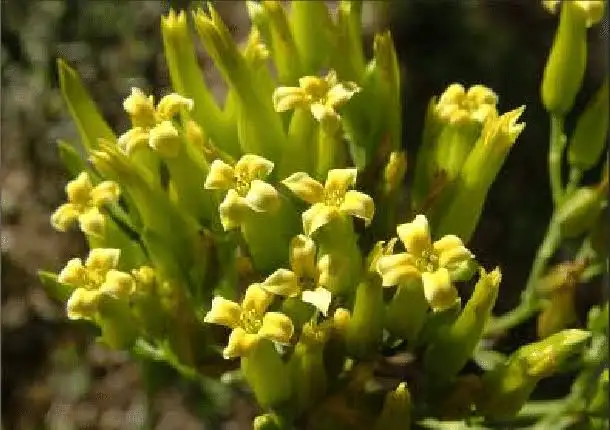
Kalanchoe paniculata also referred to as Large Orange Kalanchoe is a low growing to loosely shrubby leaf succulent that ranges in height between 0.3-1m. The stems tend to become top heavy when in flower and topple over easily. The leaves are light green and oval shaped. During winter tall inflorescence stalks bear clusters of tiny greenish-yellow flowers. The stems die back after flowering. Kalanchoe paniculata is ideal for a rockery or even a mixed succulent garden bed in full sun. It is also suitable for containers, rock gardens, retaining walls and water-wise or arid gardens.
Kalanchoe pumila
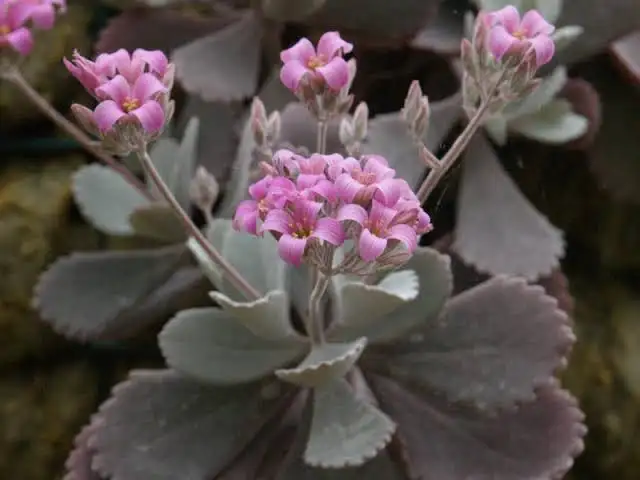
Kalanchoe pumila also referred to as, the flower dust plant, grows to 20 cm (8 in) tall and 45 cm (18 in) wide, it is a spreading, dwarf succulent subshrub with arching stems of frosted leaves, and clusters of purple-veined pink flowers in spring. These plants are used in hanging pots on terraces, patios or well-lit and ventilated interiors. In winter regions without frost they are used in rockeries and low walls.
Also Read: Common Types of Aloe Vera Varieties
Kalanchoe rotundifolia
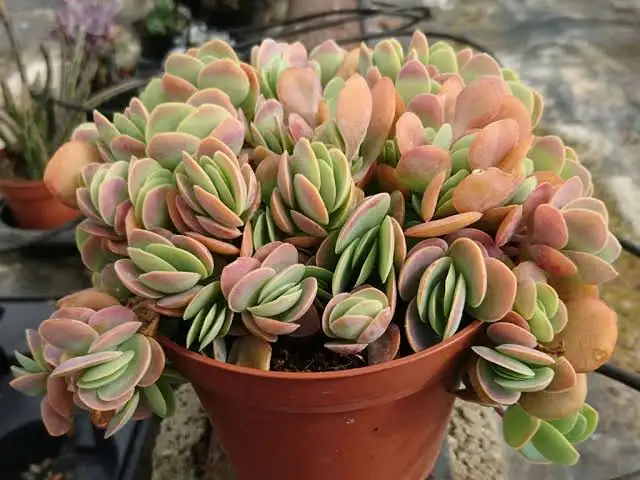
Kalanchoe rotundifolia also referred to as common Kalanchoe is a sparely and slenderly branched, erect succulent with blue-ish green leaves that can reach a height of 1m. The leaves are generally egg shaped but the plant varies quite a lot in leaf colour, shape and margins which may be rounded, toothed or lobed. Between autumn and mid-summer Kalanchoe rotundifolia bears orange to scarlet four lobed flowers in clusters on stalks high above the foliage. It can tolerate full sun but often does better in semi-shaded positions in a rockery or succulent garden.
Kalanchoe sexangularis

Kalanchoe sexangularis also referred to as Six-angled Kalanchoe grows upright on square stems that are green when young and become brown and flaky as they mature. The stems have a tendency to be lax and droopy and lie flat as the leaves become too large and heavy for the thin stems to support. Its attractive, broad, glossy and deeply serrated foliage reach lengths of 50–120 mm. When grown in shade the leaves tend to be greenish red, more green than red, but when in full sun, they tend to be ruby red. The leaves also turn red when there is a drop in temperature during the winter months. It has small, yellow, tubular flowers on a tall, branched inflorescence are seen in winter.